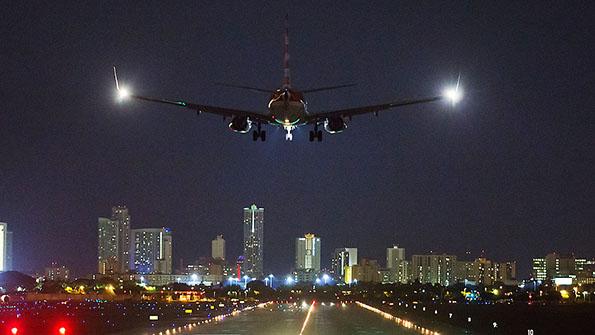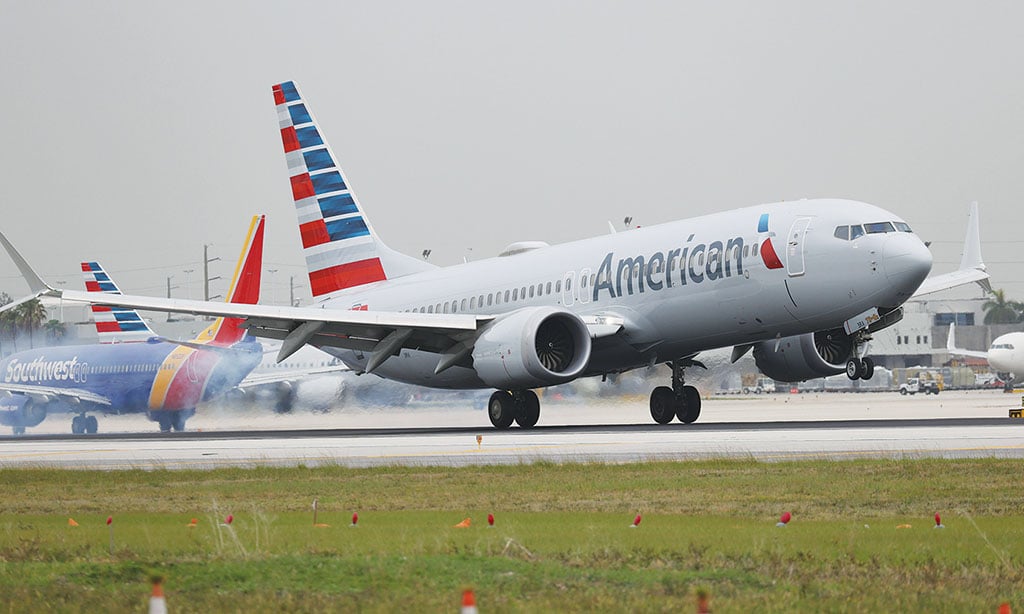
The FAA’s Air Traffic Organization protocols will be examined as part of the safety review.
The FAA’s industry-wide safety call to action reprises a tactic most recently used in 2010, with one major difference—progress since then means that the risks and related ramifications are more difficult to pinpoint.
Acting FAA Administrator Billy Nolen’s Feb. 14 declaration to agency leadership that a deep, collaborative examination of emerging safety risks comes in a starkly different environment than a similar push by then-Administrator Randy Babbitt 13 years ago. In the decade leading up to Babbitt’s wake-up call, nine U.S. commercial airline accidents resulted in 508 fatalities. Probes into the incidents—notably the February 2009 Colgan Air Flight 3407 accident that killed 49 and sparked pilot-training changes—combined with NTSB recommendations and a lingering FAA to-do list left no shortage of action items.
- Dedicated team will review industry safety practices
- Risk-reduction plan will leverage data
Today, in part because of the work advanced by that 2010 push, the U.S. airline safety record is stronger. Two passengers have died in Part 121 airline accidents since the Colgan crash. Even when factoring in fatalities from several cargo airline accidents and ground occurrences, the industry has clearly made progress.
But a spate of recent high-profile incidents underscores that such progress can be as fleeting as it is notable.
“We are experiencing the safest period in aviation history, but we cannot take this for granted,” Nolen writes in his memo. “Recent events remind us that we must not become complacent.”
The memo does not specify any events, but the NTSB’s growing tally of new investigations leaves little doubt about the sources of Nolen’s concerns. Since mid-December, the board has launched probes into at least seven occurrences involving U.S. airlines. Particularly troubling is the number of seemingly serious ones. During three separate runway incursions, pilots in one of the aircraft had to take evasive action to avoid a collision. In addition, a turbulence-induced accident involving a Hawaiian Airlines Airbus A330 left multiple passengers and crew injured, some seriously. The list includes one fatal accident when a ramp worker walked in front of an Envoy Air Embraer 175’s power-up engine and was killed.
None of the investigations are complete, and several have not reached the preliminary-report stage when initial facts are made public. While no clear links between the occurrences have emerged, the broad trend of multiple close calls in a short span amid a rapid post-downturn ramp-up is enough to raise eyebrows of even seasoned observers.
“Coming back from the pandemic, we went from 20% of the schedules to in some cases over 100% today,” Babbitt says. “That meant a lot of getting back up to speed for pilots, controllers” and others. “There have been a lot of little mistakes, but little mistakes add up.”
Regulators and industry safety leaders acknowledge that the pandemic’s disruption increased risk levels. Pilots stopped flying regularly, and training routines were interrupted. Early retirements at many airlines that were designed to save money also diminished payroll value and reduced the number of experienced pilots.
Even factoring in these issues, safety risks were easier to spot when Babbitt spearheaded the FAA’s call to action. More than a dozen Part 121 carriers—most of them smaller operators—lacked a comprehensive remedial training program for pilots, for instance, while neither safety management systems nor upset recovery training was mandatory. The Colgan accident and several others spotlighted pilot professionalism problems—a 2007 NTSB recommendation called for industry to “address professional standards and their role in ensuring safety of flight”—and the benefits of formalized leadership training for captains.
The agency’s 10-point action plan focused on enhancing pilot performance and training as well as boosting airline participation in voluntary safety programs. New rules and voluntary efforts by carriers addressed the major issues, although a few—such as required captain leadership training set to begin in April of this year—took years to go into effect.
This time around, there are fewer universally acknowledged gaps. So industry leaders must determine what issues merit consideration for a notional action plan.
The first step is forming a “safety review team” to take a broad look at “the U.S. aerospace system’s structure, culture, processes, systems and integration of safety efforts,” Nolen writes. Work will begin with a March summit “to examine what additional actions the aviation community needs to take to maintain our safety record,” the memo states. The plan calls for collaboration among commercial and general aviation leaders as well as major labor-group representatives.
Meanwhile, the FAA’s Commercial Aviation Safety Team (CAST) will examine Aviation Safety Information Analysis and Sharing program safety data compiled from myriad sources, including voluntary operator submissions, to determine what might be missing. Formed in 1997 to flag safety risks using data and to develop plans to reduce those risks, CAST has arguably made the most significant contributions to U.S. commercial aviation’s improved safety record.

“We need to mine the data to see whether there are other incidents that resemble ones we have seen in recent weeks,” Nolen writes. “And we need to see if there are indicators of emerging trends so we can focus on resources to address now.”
The safety review team will “focus” on the FAA’s Air Traffic Organization, the agency unit that operates the National Airspace System, the memo states. Among the specific topics it will address: a stronger link with the FAA’s Aviation Safety unit, particularly in monitoring and mitigating safety risks.
Such collaboration is crucial for understanding trends that are shaping increasingly complex risk scenarios. Mechanical reliability failures that lead to catastrophes are extremely rare, and pilots have never been better trained or had access to more capable systems—from flight deck automation to advanced threat detection. Mix in targeted safety systems, such as airport surface collision monitoring, and most of risk reduction’s low-hanging fruit has been harvested.
Much of the remaining risk is rooted in human error. But even there, advances such as improved cockpit systems have helped increase safety margins. The result is that accidents stem from increasingly complex event chains that combine multiple operational arenas—a maintenance error compounded by a pilot missing an alert, for instance. They are hard to dissect and even harder to anticipate.
A recent runway incursion at Austin-Bergstrom International Airport (AUS), involving a Southwest Airlines Boeing 737-700 and a FedEx 767-300, is shaping up to be a prime example of how a complex combination of factors creates unacceptable risk.
Investigators have not released any details of the Feb. 4 occurrence. Unverified, publicly available flight-tracking data and recorded communications between the aircraft and air traffic control (ATC) suggest that the 737, operating as Flight WN708, was cleared to depart on Runway 18 Left (18L) in front of the 767, FedEx Flight 1432. The Southwest crew was told the freighter was inbound on a 3-mi. instrument approach to the same runway. But the 737 apparently did not begin its takeoff roll for at least another 30 sec.
Two sources familiar with the probe said conditions at the time of the occurrence—surface air temperature below 3C (37.4F) and visible moisture, in this case fog—required the pilots to perform an additional 30 sec. engine run-up.
Because of the fog, the tower controllers could not see the runway end, Nolen confirmed during a Feb. 15 Senate hearing that touched on the incident.
According to the ATC recordings, a WN708 pilot radioed that the 737 was at Runway 18L and “ready” for takeoff. ATC cleared WN708 for departure, alerting the crew to the inbound 767 on a 3-mi. final. WN708 acknowledged its clearance and the inbound traffic.
“I guess the controller just assumed when [the Southwest pilot] said ‘ready,’ he was going to pull up and go,” one former mainline pilot with knowledge of the probe tells Aviation Week. WN708 “had plenty of room to start,” the source adds. “But maybe he’s a little slow getting into position. Then he sits out there 30 sec.—if that arriving aircraft is [flying] at 120 kt., that’s a mile. The separation goes away fast.”
As WN708 began to roll, the FedEx aircraft was approaching the runway threshold and soon realized the 737 was just ahead and below, public data show. The FedEx crew executed a go-around and a “possible” overflight of WN708, the NTSB says, before returning to Austin. WN708 departed and completed its scheduled flight to Cancun, Mexico.
“Nobody did anything wrong,” the former pilot says. “But yet, it wasn’t right.”
Besides WN708’s predeparture routine, investigators are expected to look at ATC separation protocols, which one former FAA engineer with extensive air traffic management experience says merit close scrutiny.
“The fault [at AUS] lies squarely with our current [ATC] system’s faulty criteria and also inappropriately reducing separation limits for landing of aircraft trailing behind departures,” the former FAA engineer says. “[ATC] is now using far closer longitudinal limits than appropriate” to ensure safe separation in case of events such as rejected takeoffs or longer-than-expected predeparture sequences, the engineer adds.
Nolen was pressed for information on the probe during the hearing, even though NTSB protocol prohibits outsiders from sharing details without the board’s consent.
“What happened in Austin is something we would not expect to happen during a low-visibility operation, where Southwest was cleared for takeoff and FedEx . . . was cleared for approach in close proximity to each other,” he said. “It is not something we expect to have taken place.”





